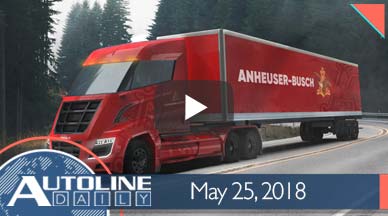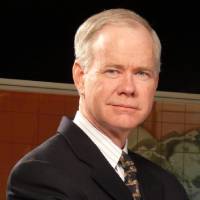
Runtime: 8:00
0:35 Uber At Fault for Fatal Autonomous Accident
1:33 BMW & MIT Create Printed Inflatable Materials
2:47 Hydrogen Network for Fuel Cell Semi Trucks
3:45 Nikola Taps Bosch for Fuel Cell Development
4:09 Mercedes Expands E-Class Family
5:08 How GM Balances Its Scale
Visit our sponsors to thank them for their support of Autoline Daily: Bridgestone , Dow Automotive Systems , Lear Corporation , BorgWarner and ExxonMobil.
On today’s show…the NTSB says Uber is at fault in the fatal accident involving one of its self-driving cars…Anheuser Busch is setting up a hydrogen infrastructure to help fuel cell semis transport its beer…and BMW and MIT create inflatable materials that can be 3D printed. All that and more coming right up on Autoline Daily.
This is Autoline Daily the show for enthusiasts of the automotive industry.
UBER AT FAULT FOR FATAL AUTONOMOUS ACCIDENT
The National Transportation Safety Board has released its preliminary findings into the fatal crash involving an Uber autonomous test vehicle in Arizona. The autonomous system installed by Uber registered the pedestrian 6-seconds before impact, while it was travelling a little over 40 miles-per-hour. That should have been more than enough time to stop, but the system never engaged the brakes. Despite the test vehicle, a Volvo XC90 coming with a number of driver assist systems from the factory, including automatic emergency braking, Uber disabled these functions while the vehicle was in autonomous mode “to reduce the potential for erratic vehicle behavior.” Some are speculating that to mean Uber was having problems with false brake engagement, like at overpasses and for road signs, and that it turned off the assist features rather than address the issue. The system was also not designed to alert the operator.
BMW & MIT CREATE PRINTED INFLATABLE MATERIALS
The most recent Autoline After Hours was all about the current state of 3D printing in the automotive industry, but BMW is studying how the technology could be applied to future interiors and, along with MIT, has come up with an interesting solution. They’ve figured out how to make a printable material that’s both air and water tight. Liquid silicone is used to build the structure of the material and it’s able to transform into a variety of shapes, functions or even stiffness’s. BMW says the material “points towards a future of transformable surfaces for adaptive human comfort, cushioning and impact performance.”
Still to come…Anheuser Busch wants to set up a hydrogen refueling network for fuel cell semi-trucks transporting its beer.
HYDROGEN NETWORK FOR FUEL CELL SEMI TRUCKS
One of the challenges holding back the use of fuel cells is building a hydrogen infrastructure to refuel them. But Anheuser Busch has an interesting way to solve this. It operates 13 breweries in the United States that ship beer every day to distribution points. They use the same routes at the same time every day. So it wants to set up a series of hubs on highways in the western U.S. where fuel cell semis could refuel. Nikola will make the semis and it will manufacture hydrogen at those hubs using hydrolysis and renewable electricity. That would drastically cut down the cost of the hydrogen. The hubs will be 200 to 600 miles apart and another advantage is that drivers can drive to a hub, then switch to another truck and return. That way they would be home every night, instead of being on the road for days on end. This could help truck fleets attract more drivers since they face a driving shortage right now.
NIKOLA TAPS BOSCH FOR FUEL CELL DEVELOPMENT
Nikola is developing the fuel cell semi in collaboration with Bosch. And it has some impressive stats: 1,000 horsepower and 2,000 pound-feet of torque. That would give it performance far better than any diesel semi has today. And by using a fuel cell instead of batteries to power the truck, Nikola says it would weigh the same as a diesel-powered truck.
MERCEDES EXPANDS E-CLASS FAMILY
Mercedes is adding two new model designations to the E-Class family, the E 450 and 450 4MATIC. They will get an upgraded 3.0L twin turbo V6 engine with 33 more horsepower and 15 more lb-ft of torque. There’s also a new 3-spoke steering wheel, two new interior trim options with matching center consoles, unique 19-inch wheels and a Rear Safety Package is new the car. Look for the 2019 E-Class 450 models to go on sale this fall.
Coming up next, GM’s President, Dan Ammann explains how the company is balancing its scale while leaving unprofitable markets.
HOW GM BALANCES ITS SCALE
The auto industry has always been predicated on scale. The car company that can make the most cars, can amortize the cost of making them. However, General Motors is actively reducing its scale. Its pulled out of Europe and a number of other markets recently. On Autoline This Week, we’re joined by Dan Ammann, the President of GM, and he explained how the automaker is balancing its scale while exiting unprofitable markets.
(The ATW preview is only available in the video version of today’s show.)
You can watch that entire discussion with Dan Ammann right now on our website, Autoline.tv or you can find it on our YouTube channel.
Just a quick programming note before I sign off. There won’t be a new Autoline Daily on Monday due to the Memorial Day holiday.
But that’s it for today, thanks for watching and we’ll see you again on Tuesday.
Thanks to our partner for embedding Autoline Daily on its website: WardsAuto.com

John McElroy is an influential thought leader in the automotive industry. He is a journalist, lecturer, commentator and entrepreneur. He created “Autoline Daily,” the first industry webcast of industry news and analysis.




